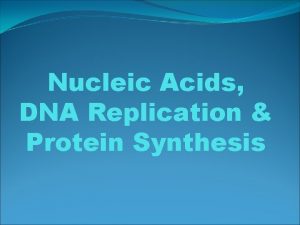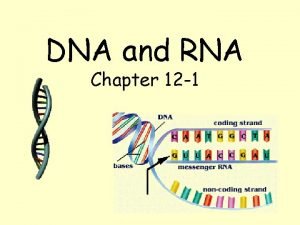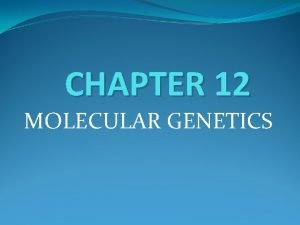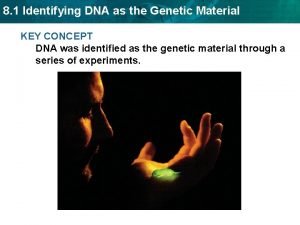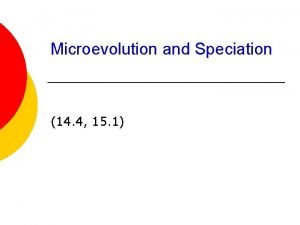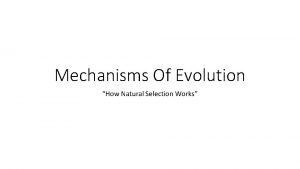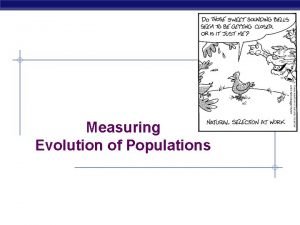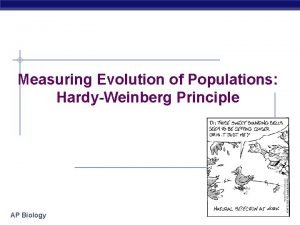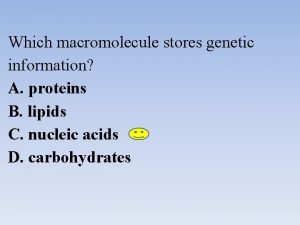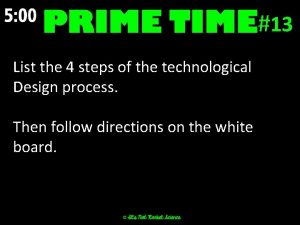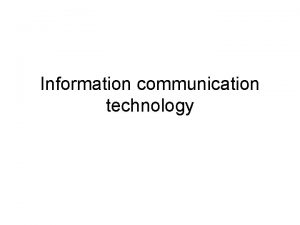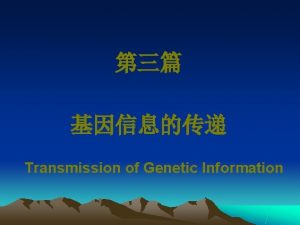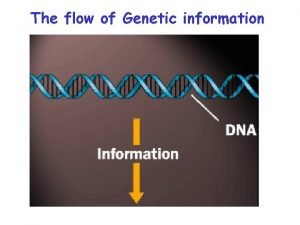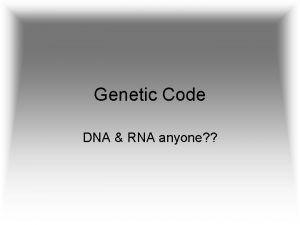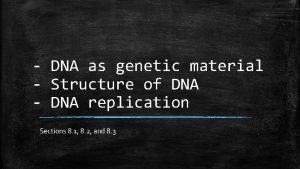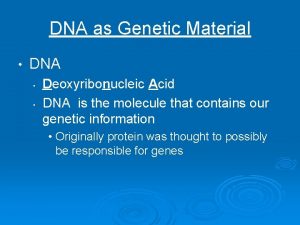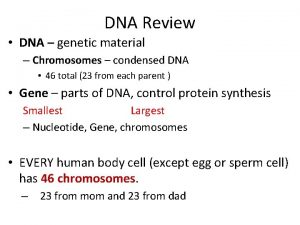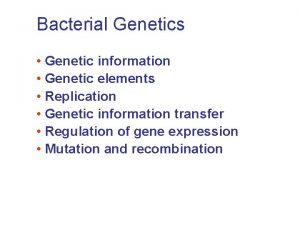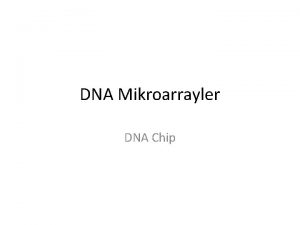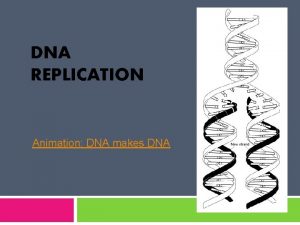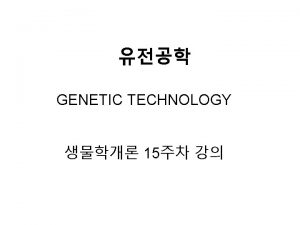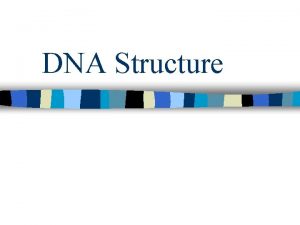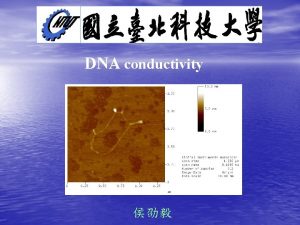THE FLOW OF GENETIC INFORMATION FROM DNA TO







































- Slides: 39

THE FLOW OF GENETIC INFORMATION FROM DNA TO RNA TO PROTEIN • 10. 6 The DNA genotype is expressed as proteins, which provide the molecular basis for phenotypic traits • The information constituting an organism’s genotype – Is carried in its sequence of its DNA bases • A particular gene, a linear sequence of many nucleotides – Specifies a polypeptide Copyright © 2005 Pearson Education, Inc. Publishing as Benjamin Cummings

• The DNA of the gene is transcribed into RNA – Which is translated into the polypeptide DNA Transcription RNA Translation Protein Figure 10. 6 A Copyright © 2005 Pearson Education, Inc. Publishing as Benjamin Cummings

10. 7 Genetic information written in codons is translated into amino acid sequences • The “words” of the DNA “language” – Are triplets of bases called codons • The codons in a gene – Specify the amino acid sequence of a polypeptide Copyright © 2005 Pearson Education, Inc. Publishing as Benjamin Cummings

DNA molecule Gene 1 Gene 2 Gene 3 DNA strand A A A C C G G C A A Transcription RNA Translation U U U G G C C G U U Codon Polypeptide Figure 10. 7 Amino acid Copyright © 2005 Pearson Education, Inc. Publishing as Benjamin Cummings

10. 8 The genetic code is the Rosetta stone of life • Nearly all organisms – Use exactly the same genetic code Second base U C UUU Phe UUC UCU UCC UUA UCA UUG Leu CUU First base C A CUC CUA CUG Leu AUU AUC Ile G GUA GUG Figure 10. 8 A Copyright © 2005 Pearson Education, Inc. Publishing as Benjamin Cummings UAC UGU Cys U UGC C UAA Stop UGA Stop A UGG Trp CCU CAU His CAC CGU CGC CAA CAG Gln CGA CGG AAU Asn AAC U AGU Ser AGC C AAA AGA A AGG Arg G U GGU C GGC Gly GGA A CCC CCA CCG Pro ACU ACC GCU GCC Val Ser Tyr UAG Stop ACA Met or ACC AUG start GUU UAU G UCG AUA GUC A GCG Thr AAG GAU Ala GAC GAA GAG Lys Asp Glu GGG G U Arg C A G G Third base U

• An exercise in translating the genetic code Strand to be transcribed T A C T T C A A T C A T G A A G T T A G U A G DNA Transcription A U G A A G U U U RNA Start condon Stop condon Translation Figure 10. 8 B Polypeptide Met Copyright © 2005 Pearson Education, Inc. Publishing as Benjamin Cummings Lys Phe

10. 9 Transcription produces genetic messages in the form of RNA • A close-up view of transcription RNA nucleotides RNA polymerase A A T C C A T A G G T Direction of transcription Figure 10. 9 A Newly made RNA Copyright © 2005 Pearson Education, Inc. Publishing as Benjamin Cummings A T A G U C A U G U T C G T T C C A A C C Template Strand of DNA

• In the nucleus, the DNA helix unzips – And RNA nucleotides line up along one strand of the DNA, following the base pairing rules • As the single-stranded messenger RNA (m. RNA) peels away from the gene – The DNA strands rejoin Copyright © 2005 Pearson Education, Inc. Publishing as Benjamin Cummings

• Transcription of a gene RNA polymerase DNA of gene Promoter DNA Terminator DNA 1 Initiation 2 Elongation 3 Termination Completed RNA Figure 10. 9 B Copyright © 2005 Pearson Education, Inc. Publishing as Benjamin Cummings Area shown In Figure 10. 9 A Growing RNA polymerase

10. 10 Eukaryotic RNA is processed before leaving the nucleus • Noncoding segments called introns are spliced out – And a cap and a tail are added to the ends Exon Intron Exon DNA Cap RNA transcript with cap and tail Transcription Addition of cap and tail Introns removed Tail Exons spliced together m. RNA Coding sequence Nucleus Cytoplasm Figure 10. 10 Copyright © 2005 Pearson Education, Inc. Publishing as Benjamin Cummings

10. 11 Transfer RNA molecules serve as interpreters during translation • Translation – Takes place in the cytoplasm Copyright © 2005 Pearson Education, Inc. Publishing as Benjamin Cummings

• A ribosome attaches to the m. RNA – And translates its message into a specific polypeptide aided by transfer RNAs (t. RNAs) Amino acid attachment site Hydrogen bond RNA polynucleotide chain Figure 10. 11 A Copyright © 2005 Pearson Education, Inc. Publishing as Benjamin Cummings Anticodon

• Each t. RNA molecule – Is a folded molecule bearing a base triplet called an anticodon on one end • A specific amino acid – Is attached to the other end Amino acid attachment site Figure 10. 11 B, C Anticodon Copyright © 2005 Pearson Education, Inc. Publishing as Benjamin Cummings

10. 12 Ribosomes build polypeptides • A ribosome consists of two subunits – Each made up of proteins and a kind of RNA called ribosomal RNA t. RNA molecules Growing polypeptide Large subunit m. RNA Figure 10. 12 A Copyright © 2005 Pearson Education, Inc. Publishing as Benjamin Cummings Small subunit

• The subunits of a ribosome – Hold the t. RNA and m. RNA close together during translation t. RNA-binding sites Large subunit Next amino acid to be added to polypeptide Growing polypeptide t. RNA m. RNAbinding site m. RNA Small subunit Codons Figure 10. 12 B, C Copyright © 2005 Pearson Education, Inc. Publishing as Benjamin Cummings

10. 13 An initiation codon marks the start of an m. RNA message Start of genetic message End Figure 10. 13 A Copyright © 2005 Pearson Education, Inc. Publishing as Benjamin Cummings

• m. RNA, a specific t. RNA, and the ribosome subunits – Assemble during initiation Met Large ribosomal subunit Initiator t. RNA P site UA C A U G U A C A U G Start codon 1 m. RNA A site Small ribosomal subunit Figure 10. 13 B Copyright © 2005 Pearson Education, Inc. Publishing as Benjamin Cummings 2

10. 14 Elongation adds amino acids to the polypeptide chain until a stop codon terminates translation • Once initiation is complete – Amino acids are added one by one to the first amino acid Copyright © 2005 Pearson Education, Inc. Publishing as Benjamin Cummings

• Each addition of an amino acid – Occurs in a three-step elongation process Amino acid Polypeptide P site A site m. RNA Codons Anticodon 1 Codon recognition m. RNA movement Stop codon 2 Peptide bond formation New Peptide bond Figure 10. 14 Copyright © 2005 Pearson Education, Inc. Publishing as Benjamin Cummings 3 Translocation

• The m. RNA moves a codon at a time – And a t. RNA with a complementary anticodon pairs with each codon, adding its amino acid to the peptide chain Copyright © 2005 Pearson Education, Inc. Publishing as Benjamin Cummings

• Elongation continues – Until a stop codon reaches the ribosome’s A site, terminating translation Copyright © 2005 Pearson Education, Inc. Publishing as Benjamin Cummings

10. 15 Review: The flow of genetic information in the cell is DNA RNA protein • The sequence of codons in DNA, via the sequence of codons – Spells out the primary structure of a polypeptide Copyright © 2005 Pearson Education, Inc. Publishing as Benjamin Cummings

• Summary of transcription and translation DNA Transcription 1 m. RNA is transcribed from a DNA template. m. RNA polymerase Amino acid Translation 2 Each amino acid attaches to its proper t. RNA with the help of a specific enzyme and ATP. Enzyme ATP t. RNA Anticodon Large ribosomal subunit Initiator t. RNA 3 Initiation of polypeptide synthesis The m. RNA, the first t. RNA, and the ribosomal subunits come together. Start Codon m. RNA Small ribosomal subunit New peptide bond forming Growing polypeptide 4 Elongation A succession of t. RNAs add their amino acids to the polypeptide chain as the m. RNA is moved through the ribosome, one codon at a time. Codons m. RNA Polypeptide 5 Termination The ribosome recognizes a stop codon. The poly-peptide is terminated and released. Figure 10. 15 Copyright © 2005 Pearson Education, Inc. Publishing as Benjamin Cummings Stop codon

10. 16 Mutations can change the meaning of genes • Mutations are changes in the DNA base sequence – Caused by errors in DNA replication or recombination, or by mutagens Normal hemoglobin DNA C T T m. RNA A T G U A C m. RNA G Figure 10. 16 A Mutant hemoglobin DNA A A Normal hemoglobin Glu Copyright © 2005 Pearson Education, Inc. Publishing as Benjamin Cummings Sickle-cell hemoglobin Val

• Substituting, inserting, or deleting nucleotides alters a gene – With varying effects on the organism Normal gene m. RNA A U G A A G U U U G G C A Met Protein Lys Phe Gly Ala Base substitution A U G A A G U U U A G C A Met Lys Phe Ser Ala U Missing Base deletion A U G A A G U U G G C A U Figure 10. 16 B Met Copyright © 2005 Pearson Education, Inc. Publishing as Benjamin Cummings Lys Leu Ala His

MICROBIAL GENETICS 10. 17 Viral DNA may become part of the host chromosome • Viruses – Can be regarded as genes packaged in protein Copyright © 2005 Pearson Education, Inc. Publishing as Benjamin Cummings

• When phage DNA enters a lytic cycle inside a bacterium – It is replicated, transcribed, and translated • The new viral DNA and protein molecules – Then assemble into new phages, which burst from the host cell Copyright © 2005 Pearson Education, Inc. Publishing as Benjamin Cummings

• In the lysogenic cycle – Phage DNA inserts into the host chromosome and is passed on to generations of daughter cells • Much later – It may initiate phage production Copyright © 2005 Pearson Education, Inc. Publishing as Benjamin Cummings

• Phage reproductive cycles Phage 1 Attaches to cell Bacterial chromosome Phage DNA Cell lyses, releasing phages Phage injects DNA 7 2 Many cell divisions 4 Lytic cycle Lysogenic cycle Phages assemble Phage DNA circularizes 3 5 OR New phage DNA and proteins are synthesized Figure 10. 17 Copyright © 2005 Pearson Education, Inc. Publishing as Benjamin Cummings Lysogenic bacterium reproduces normally, replicating the prophage at each cell division Prophage 6 Phage DNA inserts into the bacterial chromosome by recombination

CONNECTION 10. 18 Many viruses cause disease in animals • Many viruses cause disease – When they invade animal or plant cells • Many, such as flu viruses – Have RNA, rather than DNA, as their Membranous genetic material envelope RNA Protein coat Figure 10. 18 A Copyright © 2005 Pearson Education, Inc. Publishing as Benjamin Cummings Glycoprotein spike

• Some animal viruses – Steal a bit of host cell membrane as a protective envelope – Can remain latent in the host’s body for long periods Glycoprotein spike VIRUS Protein coat Envelope Viral RNA (genome) Plasma membrane 1 of host cell 2 Viral RNA (genome) 3 Entry Uncoating RNA synthesis by viral enzyme 4 Protein m. RNA synthesis New viral proteins 5 RNA synthesis (other strand) Template 6 Assembly Exit Figure 10. 18 B Copyright © 2005 Pearson Education, Inc. Publishing as Benjamin Cummings 7 New viral genome

CONNECTION 10. 19 Plant viruses are serious agricultural pests • Most plant viruses – Have RNA genomes – Enter their hosts via wounds in the plant’s outer layers Protein RNA Figure 10. 19 Copyright © 2005 Pearson Education, Inc. Publishing as Benjamin Cummings

CONNECTION Figure 10. 20 A, B Copyright © 2005 Pearson Education, Inc. Publishing as Benjamin Cummings Colorized TEM 370, 000 Colorized TEM 50, 000 10. 20 Emerging viruses threaten human health

10. 21 The AIDS virus makes DNA on an RNA template • HIV, the AIDS virus – Is a retrovirus Envelope Glycoprotein Protein coat RNA (two identical strands) Reverse transcriptase Figure 10. 21 A Copyright © 2005 Pearson Education, Inc. Publishing as Benjamin Cummings

• Inside a cell, HIV uses its RNA as a template for making DNA – To insert into a host chromosome Viral RNA CYTOPLASM 1 RNA strand NUCLEUS Chromosomal DNA 2 Doublestranded DNA 3 Provirus DNA 4 Viral RNA and proteins 5 RNA 6 Figure 10. 21 B Copyright © 2005 Pearson Education, Inc. Publishing as Benjamin Cummings

10. 22 Bacteria can transfer DNA in three ways • Bacteria can transfer genes from cell to cell by one of three processes – Transformation, transduction, or conjugation DNA enters cell Fragment of DNA from another bacterial cell Bacterial chromosome (DNA) Mating bridge Phage Fragment of DNA from another bacterial cell (former phage host) Figure 10. 22 A–C Copyright © 2005 Pearson Education, Inc. Publishing as Benjamin Cummings Sex pili Donor cell (“male”) Recipient cell (“female”)

• Once new DNA gets into a bacterial cell – Part of it may then integrate into the recipient’s chromosome Donated DNA Figure 10. 22 D Recipient cell’s chromosome Copyright © 2005 Pearson Education, Inc. Publishing as Benjamin Cummings Crossovers Degraded DNA Recombinant chromosome

10. 23 Bacterial plasmids can serve as carriers for gene transfer • Plasmids – Are small circular DNA molecules separate from the bacterial chromosome Copyright © 2005 Pearson Education, Inc. Publishing as Benjamin Cummings

• Plasmids can serve as carriers – For the transfer of genes F factor (plasmid) F factor (integrated) Male (donor) cell Origin of F replication Bacterial chromosome F factor starts replication and transfer of chromosome Male (donor) cell Bacterial chromosome F factor starts replication and transfer Only part of the chromosome transfers Plasmid completes transfer and circularizes Plasmids Recombination can occur Cell now male Figure 10. 23 A–C Copyright © 2005 Pearson Education, Inc. Publishing as Benjamin Cummings Colorized TEM 2, 000 Recipient cell
 Genetic drift in small populations
Genetic drift in small populations Genetic drift vs gene flow
Genetic drift vs gene flow Gene flow vs genetic drift
Gene flow vs genetic drift Flow of genetic information
Flow of genetic information Genetic programming vs genetic algorithm
Genetic programming vs genetic algorithm Genetic programming vs genetic algorithm
Genetic programming vs genetic algorithm Chapter 12 section 1 dna the genetic material
Chapter 12 section 1 dna the genetic material Chapter 12 section 1 dna the genetic material
Chapter 12 section 1 dna the genetic material Section 12-1 dna
Section 12-1 dna Chapter 12 dna the genetic material
Chapter 12 dna the genetic material Section 12-1 dna
Section 12-1 dna Section 1 identifying dna as the genetic material
Section 1 identifying dna as the genetic material Macroevolution vs microevolution
Macroevolution vs microevolution Evolution mechanisms
Evolution mechanisms What is gene flow and genetic drift
What is gene flow and genetic drift Genetic drift vs gene flow
Genetic drift vs gene flow Dna polymerase function in dna replication
Dna polymerase function in dna replication Bioflix activity dna replication dna replication diagram
Bioflix activity dna replication dna replication diagram Coding dna and non coding dna
Coding dna and non coding dna What are the enzymes involved in dna replication
What are the enzymes involved in dna replication Chapter 11 dna and genes
Chapter 11 dna and genes Which macromolecule stores energy
Which macromolecule stores energy Store and transmit hereditary
Store and transmit hereditary Which macromolecule stores our genetic information? *
Which macromolecule stores our genetic information? * Dna laboratory information management system
Dna laboratory information management system Hình ảnh bộ gõ cơ thể búng tay
Hình ảnh bộ gõ cơ thể búng tay Frameset trong html5
Frameset trong html5 Bổ thể
Bổ thể Tỉ lệ cơ thể trẻ em
Tỉ lệ cơ thể trẻ em Chó sói
Chó sói Glasgow thang điểm
Glasgow thang điểm Chúa sống lại
Chúa sống lại Các môn thể thao bắt đầu bằng tiếng chạy
Các môn thể thao bắt đầu bằng tiếng chạy Thế nào là hệ số cao nhất
Thế nào là hệ số cao nhất Các châu lục và đại dương trên thế giới
Các châu lục và đại dương trên thế giới Công thức tính thế năng
Công thức tính thế năng Trời xanh đây là của chúng ta thể thơ
Trời xanh đây là của chúng ta thể thơ Mật thư tọa độ 5x5
Mật thư tọa độ 5x5 Làm thế nào để 102-1=99
Làm thế nào để 102-1=99 độ dài liên kết
độ dài liên kết



